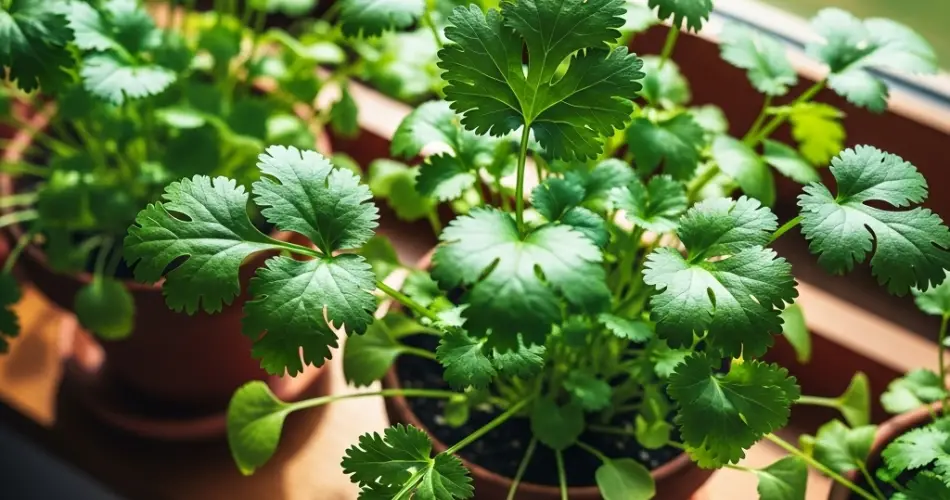Cilantro, also known as coriander, is a popular herb used in cuisines around the world. Its bright, citrusy leaves add a refreshing touch to dishes like salsas, curries, soups, and salads. Growing cilantro in pots is a smart solution for gardeners who want a fresh and manageable supply of this quick-growing herb. Containers allow you to control soil quality, drainage, and sunlight exposure, all while keeping the plant close for convenient harvesting.
Though cilantro has a reputation for being a bit tricky due to its tendency to bolt in hot weather, with the right potting setup and care, it’s easy to grow successfully—even in small spaces.
Why Grow Cilantro in Pots?
Container gardening is ideal for cilantro for several reasons:
-
You can control the temperature and light to prevent early bolting
-
It’s easy to move pots to partial shade on hot days
-
It allows for better drainage and soil customization
-
You can grow cilantro on balconies, patios, or even sunny kitchen windows
-
Regular harvesting is simple and accessible
By growing cilantro in pots, you create a micro-environment that helps extend its leaf-producing phase and ensures fresh herbs at your fingertips.
Choosing the Right Container
Cilantro has a taproot system and benefits from a deeper container. The ideal pot should be:
-
At least 8–10 inches deep to accommodate root growth
-
12 inches or wider to allow space for multiple plants
-
Made of terracotta, ceramic, plastic, or grow bags
-
Equipped with drainage holes to prevent waterlogged soil
If you plan to sow seeds successively, consider using a longer container or trough planter for staggered planting across the surface.
Best Soil for Cilantro
Cilantro prefers well-draining, fertile soil with a neutral pH of 6.2 to 6.8. Use:
-
A high-quality potting mix that retains moisture but drains well
-
Compost or aged manure mixed in to provide nutrients
-
Avoid heavy clay-based soil, which can compact in containers
To boost drainage, you can also mix in some perlite or coarse sand.
Starting Cilantro from Seed
Cilantro grows best when directly seeded into the container, as it doesn’t transplant well due to its sensitive taproot.
How to sow:
-
Scatter seeds evenly over the surface of the soil
-
Cover them with about ¼ inch of soil
-
Mist or gently water to moisten the surface
-
Keep the soil consistently moist until seedlings appear (usually within 7–10 days)
You can sow a fresh batch every 2–3 weeks for a continuous harvest, a method known as succession planting.
Sunlight and Temperature Requirements
Cilantro prefers cooler weather and grows best in temperatures between 50°F and 85°F (10°C to 29°C). In warm climates or during the summer months, cilantro tends to bolt quickly and go to seed, reducing leaf production.
Sunlight tips:
-
Provide 4–6 hours of direct sunlight daily
-
In hot regions, place pots in an area with morning sun and afternoon shade
-
Indoors, position cilantro near a south- or east-facing window
You can use a shade cloth or move containers to a slightly cooler area during heat waves.
Watering and Fertilizing
Cilantro enjoys consistent moisture but not soggy soil. Water deeply whenever the top inch of soil feels dry.
Watering tips:
-
Water at the base to prevent fungal issues on leaves
-
Avoid letting the soil dry out completely
-
Use a watering can with a fine rose to prevent disturbing young seedlings
Fertilize cilantro every 2–3 weeks with a diluted liquid fertilizer or compost tea. Don’t overfeed, as this can encourage leggy growth and reduce leaf flavor.
Thinning and Pruning
Once the seedlings are a few inches tall, thin them out to 2–4 inches apart to allow airflow and healthy growth. Crowded cilantro becomes spindly and more prone to disease.
To encourage bushier plants and prevent bolting:
-
Harvest often by cutting the outer leaves first
-
Trim flower stalks as soon as they appear
-
Avoid letting the plant flower if your goal is a long leaf harvest
Harvesting Cilantro
Cilantro can be harvested once the plant reaches 4–6 inches tall, typically within 3–4 weeks of planting. Use clean scissors to snip the outer leaves, leaving the inner stems to continue growing.
For the best flavor:
-
Harvest in the morning after dew dries
-
Pick leaves regularly to encourage new growth
-
Use fresh or store leaves in a damp paper towel in the fridge for a few days
If the plant begins to flower, you can allow it to go to seed and harvest coriander seeds later for culinary use or replanting.
Common Problems and Solutions
-
Bolting (flowering too early): Happens in hot weather. Provide partial shade and use slow-bolt seed varieties.
-
Yellowing leaves: Often a sign of overwatering or poor drainage. Let the soil dry slightly before watering again.
-
Pests (aphids, whiteflies): Use insecticidal soap or spray with neem oil.
Good airflow, healthy soil, and consistent watering are the best defenses against most issues.
Conclusion
Growing cilantro in pots is a convenient and productive way to enjoy this flavorful herb in your kitchen. With the right soil, a deep container, and some thoughtful sun and water management, you can cultivate lush, vibrant cilantro throughout the cooler months and even indoors year-round. Regular harvesting and smart placement will keep your plant leafy and full of flavor—making container-grown cilantro a valuable addition to any herb garden.



